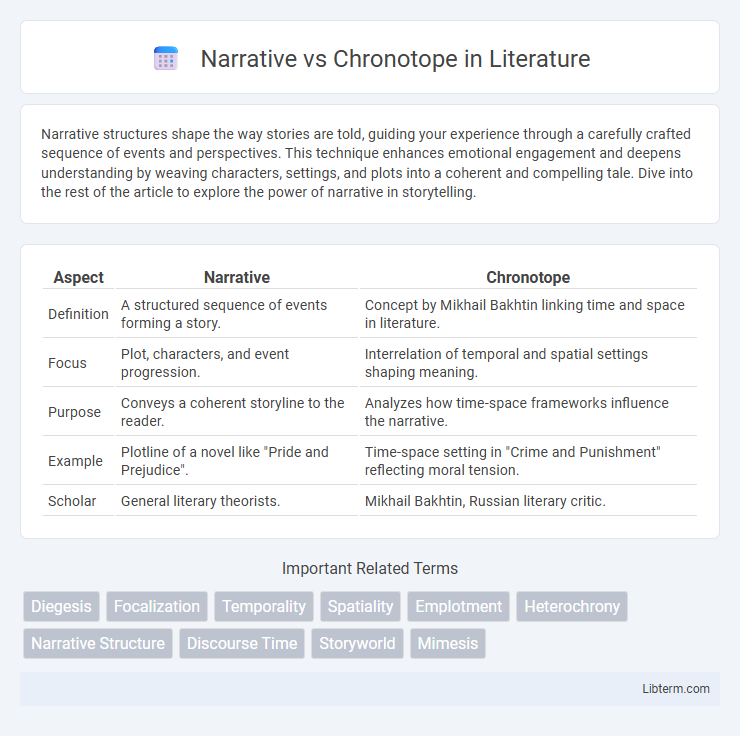Narrative structures shape the way stories are told, guiding your experience through a carefully crafted sequence of events and perspectives. This technique enhances emotional engagement and deepens understanding by weaving characters, settings, and plots into a coherent and compelling tale. Dive into the rest of the article to explore the power of narrative in storytelling.
Table of Comparison
| Aspect | Narrative | Chronotope |
|---|---|---|
| Definition | A structured sequence of events forming a story. | Concept by Mikhail Bakhtin linking time and space in literature. |
| Focus | Plot, characters, and event progression. | Interrelation of temporal and spatial settings shaping meaning. |
| Purpose | Conveys a coherent storyline to the reader. | Analyzes how time-space frameworks influence the narrative. |
| Example | Plotline of a novel like "Pride and Prejudice". | Time-space setting in "Crime and Punishment" reflecting moral tension. |
| Scholar | General literary theorists. | Mikhail Bakhtin, Russian literary critic. |
Understanding Narrative: Definition and Components
Narrative is a structured account of events or experiences, composed of key components such as plot, characters, setting, and point of view that collectively convey meaning and engage the audience. Understanding narrative involves analyzing how temporal sequences and causal relationships shape the story's progression, making it distinct from the concept of chronotope, which specifically refers to the interwoven spatial and temporal dimensions within the narrative. Mastery of narrative elements enhances comprehension of storytelling techniques and deepens insight into how stories communicate cultural values and human experiences.
Defining Chronotope: Origins and Key Concepts
Chronotope, coined by Mikhail Bakhtin, refers to the intrinsic connectedness of temporal and spatial relationships in literature, shaping how narratives unfold within specific contexts. It emphasizes the merging of time and space into a single, concrete whole, influencing plot structure and character development. This concept contrasts with narrative by foregrounding the conditions under which stories occur, providing a framework to analyze how settings and temporalities interact to produce meaning.
The Relationship Between Narrative and Chronotope
The relationship between narrative and chronotope centers on how stories are structured within specific configurations of time and space, shaping meaning and context. Chronotope, a term introduced by Mikhail Bakhtin, defines the intrinsic connection of temporal and spatial relationships in literature, directly influencing narrative progression and character development. Understanding this interplay enhances interpretation by revealing how narratives situate events and actions within dynamic temporal-spatial frameworks.
Historical Evolution of Narrative and Chronotope
The historical evolution of narrative reveals a shift from linear, event-driven storytelling to more complex structures incorporating multiple perspectives and temporal layers. The concept of chronotope, introduced by Mikhail Bakhtin, highlights how time and space are intertwined in narrative, shaping the contextual fabric of literary works. This evolution underscores the dynamic relationship between narrative form and the socio-historical contexts in which stories are embedded, reflecting changes in cultural and philosophical understandings of time and space.
Chronotope as a Framework for Storytelling
Chronotope, a concept introduced by Mikhail Bakhtin, frames storytelling by uniting time and space into a single interconnected entity that shapes narrative meaning. It provides a structural lens through which the temporal and spatial dimensions of a story interact, influencing character development and plot progression. Unlike traditional narrative frameworks that prioritize sequence, the chronotope emphasizes the intrinsic link between setting and temporal dynamics, enriching thematic depth and audience engagement.
Comparative Analysis: Narrative Structures vs. Chronotopic Structures
Narrative structures emphasize sequential events and causality, organizing stories through plot development and character progression over time. Chronotopic structures integrate spatial and temporal dimensions, presenting settings and time as interconnected frameworks influencing narrative meaning. Comparative analysis reveals that narratives prioritize event chronology while chronotopes foreground the symbiotic relationship between time and space in shaping story worlds.
The Role of Time and Space in Narrative and Chronotope
The role of time and space in narrative and chronotope deeply influences how stories are structured and understood, with narrative emphasizing the sequence of events over time and chronotope integrating temporal and spatial dimensions as inseparable elements shaping meaning. In chronotope, time and space are fused into a concrete whole, reflecting the lived experience of characters and framing the plot within the particularities of environment and historical moment. This fusion enhances thematic depth and character development by situating actions within a dynamic context where time flows and space expands or contracts according to narrative needs.
Impact on Reader Perception and Engagement
Narrative structures shape reader perception by influencing how events and emotions are processed, with chronotope grounding the story in a specific time-space framework that enhances immersion and relevance. The interplay between narrative and chronotope can intensify engagement by aligning plot development with the reader's contextual understanding and cultural expectations. This synchronization deepens emotional resonance and fosters a more vivid, memorable reading experience.
Examples in Literature: Narrative vs. Chronotope
In literature, narrative refers to the structured sequence of events or storylines presented to the reader, such as the linear progression in Jane Austen's "Pride and Prejudice." The chronotope, a concept developed by Mikhail Bakhtin, represents the intrinsic connectedness of temporal and spatial relationships in a narrative, exemplified by the road journey symbolizing transformation in "The Grapes of Wrath" by John Steinbeck. Whereas narrative emphasizes plot development, the chronotope enriches the text by embedding time and space into the thematic and character dynamics.
Integrating Narrative and Chronotope in Modern Storytelling
Integrating narrative and chronotope in modern storytelling enhances temporal and spatial dimensions, creating immersive experiences that reflect complex realities. The chronotope shapes the framework within which narrative events unfold, enabling storytellers to manipulate time and space to deepen thematic resonance and character development. This synthesis allows for innovative narrative structures, enriching audience engagement through layered temporal-spatial dynamics.
Narrative Infographic

 libterm.com
libterm.com